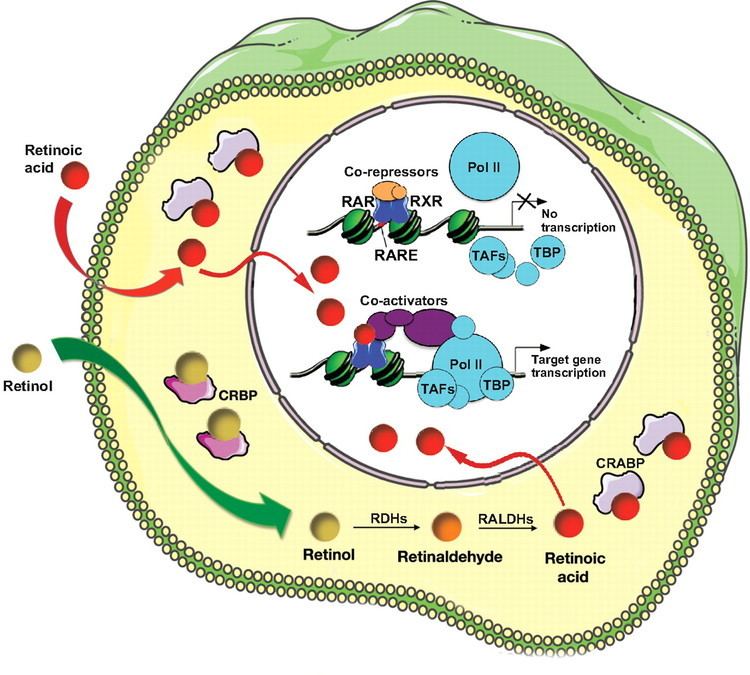Formula C20H28O2 Melting point 180 °C | Molar mass 300.4351 g/mol Pubchem 444795 | |
 | ||
Appearance yellow to light orange crystalline powder with characteristic floral odor Related compounds IUPAC ID (2E,4E,6E,8E)-3,7-dimethyl-9-(2,6,6-trimethylcyclohexen-1-yl)nona-2,4,6,8-tetraenoic acid | ||
Retinoic acid
Retinoic acid is a metabolite of vitamin A (retinol) that mediates the functions of vitamin A required for growth and development. Retinoic acid is required in chordate animals, which includes all higher animals from fish to humans. During early embryonic development, retinoic acid generated in a specific region of the embryo helps determine position along the embryonic anterior/posterior axis by serving as an intercellular signaling molecule that guides development of the posterior portion of the embryo. It acts through Hox genes, which ultimately control anterior/posterior patterning in early developmental stages.
Contents
- Retinoic acid
- Retinoic acid signaling pathway
- Mechanism of biological action
- Biosynthesis
- Retinoic acid function in the absence of precursors retinol or retinaldehyde
- Related pharmaceuticals
- References
The key role of retinoic acid in embryonic development mediates the high teratogenicity of retinoid pharmaceuticals, such as isotretinoin used for treatment of cancer and acne. Oral megadoses of pre-formed vitamin A (retinyl palmitate), and retinoic acid itself, also have teratogenic potential by this same mechanism.
Retinoic acid signaling pathway
Mechanism of biological action
Retinoic acid acts by binding to the retinoic acid receptor (RAR), which is bound to DNA as a heterodimer with the retinoid X receptor (RXR) in regions called retinoic acid response elements (RAREs). Binding of the retinoic acid ligand to RAR alters the conformation of the RAR, which affects the binding of other proteins that either induce or repress transcription of a nearby gene (including Hox genes and several other target genes). Retinoic acid receptors mediate transcription of different sets of genes controlling differentiation of a variety of cell types, thus the target genes regulated depend upon the target cells. In some cells, one of the target genes is the gene for the retinoic acid receptor itself (RAR-beta in mammals), which amplifies the response. Control of retinoic acid levels is maintained by a suite of proteins that control synthesis and degradation of retinoic acid.
The molecular basis for the interaction between retinoic acid and the Hox genes has been studied by using deletion analysis in transgenic mice carrying constructs of GFP reporter genes. Such studies have identified functional RAREs within flanking sequences of some of the most 3' Hox genes (including Hoxa1, Hoxb1, Hoxb4, Hoxd4), suggesting a direct interaction between the genes and retinoic acid. These types of studies strongly support the normal roles of retinoids in patterning vertebrate embryogenesis through the Hox genes.
Biosynthesis
Retinoic acid can be produced in the body by two sequential oxidation steps that convert retinol to retinaldehyde to retinoic acid, but once produced it cannot be reduced again to retinol. The enzymes that generate retinoic acid for control of gene expression include retinol dehydrogenases (i.e. Rdh10) that metabolize retinol to retinaldehyde, and retinaldehyde dehydrogenases: RALHD1 (ALDH1A1), RALHD2 (ALDH1A2), and RALHD3 (ALDH1A3) that metabolize retinaldehyde to retinoic acid. Enzymes that metabolize excess retinol to prevent toxicity include alcohol dehydrogenase and cytochrome P450(cyp26).
Retinoic acid function in the absence of precursors retinol or retinaldehyde
Retinoic acid is responsible for most of the activity of vitamin A, save visual pigment effects that require retinal (retinaldehyde), and cell metabolism effects that may require retinol itself. Also, some biochemical functions necessary for fertility in vitamin A deficient male and female mammals originally appeared to require retinol for rescue, but this is due to a requirement for local conversion of retinol to retinoic acid, as administered retinoic acid does not reach some critical tissues unless given in high amounts. Thus, if animals are fed only retinoic acid but no vitamin A (retinol or retinal), they suffer none of the growth-stunting or epithelial-damaging effects of lack of vitamin A (including no xerophthalmia—dryness of the cornea). They do suffer retina degeneration and blindness, due to retinal (retinaldehyde) deficiency.
In addition, vitamin A-deprived but retinoic acid-supplemented male rats exhibit hypogonadism and infertility due to lack of local retinoic acid synthesis in the testis; similar treatment of female rats causes infertility due to fetal resorption caused by a lack of local retinoic acid synthesis in the embryo. The retinoic acid synthesis in testes is catalyzed primarily by the RALDH2 (ALDH1A2) aldehyde dehydrogenase. Suppressing this enzyme has been proposed as a possible way to make a male contraceptive pill, because retinoic acid is necessary for spermatogenesis in humans much like in rats.
